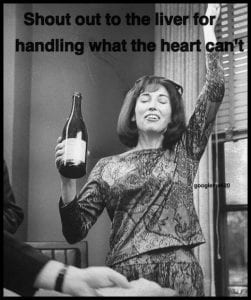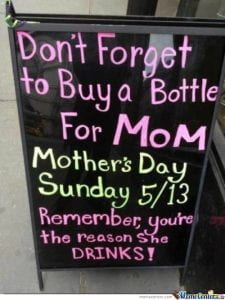In the past few years a phenomenon that has been dubbed “Mommy juice” has dominated a variety of social media platforms and marketing techniques. The term mommy juice was made to represent the drinks mothers may need in order to cope with a long day of parenting stress. In addition to dealing with the everyday stresses and anxieties, these women are facing additional pressures navigating through modern parenting. Unfortunately, the common consensus for dealing with these issue have seemed to turn towards drinking as a mechanism. Memes depicting this social structure are shared constantly on Twitter and Facebook. Products such as Mommy juice wines and accompanying novelty glasses can be found at most retails store, and drinking now more frequently occurs at events where not previously found, such as children’s sporting events and play dates. The potentials for this increasingly popular behavior are dangerous on many levels.
Children whose mothers regularly partake in their, perhaps nightly, indulgence of mommy juice can grow up with the unhealthy idea that alcohol is a safe coping outlet for dealing with stress, which could not be further from the truth. Children learn drinking habits from their parents and heavy drinking observed by children is a major indicator of how their relationship will be with alcohol in the future. The dangers of long term drinking are well known. If these children grow to adapt their mothers ideas of drinking to alleviate negative feelings, they are potentially at risk for the effects such as addiction, unhealthy coping tactics, and liver damage. Children are often observant to such behavior and it is entirely possible they pick up the habit of the necessity of mommy juice if exposed often enough. Beyond that, these children can also grow up with a notion of normalized drinking in inappropriate places.
Small anecdote from my own life. My younger brother competes in baseball tournaments during the summers; they’re often all day events with multiple games spread out. I went to one Saturday tournament and as I watched I noticed so many of the moms never strayed far from their large colorful thermoses; at one point I leaned over to my own mother and naively asked if they were all that caffeine addicted to be drinking coffee in the middle of a summer day. My mom kinda laughed and told me they fill them up with wine in between games. Sure enough, at one point most of them huddled together and took turns filling up their thermoses. Little was done to hide this fact. I felt that it was somewhat shocking. I’m not unfamiliar with the idea of alcohol at sporting events, but for it to be a children’s game, in the middle of the day, it just seemed out of place. I didn’t attend every game, so I can’t say for certain whether this was a regular occurrence or not, but assuming so, these children can become confused with the social appropriateness of when and where alcohol is seen as acceptable. This concept is not an uncommon event. The following link (IDGAF Mama’s) shows a meme that was shared in a Facebook group titled “IDGAF Mama’s”. The meme encourages an undercover mommy juice blend that can be concealed to look like a Starbucks drink. The picture has been liked more then 3,000 times and shared almost 9,000 times. Moms are undoubtedly relating to it.
On the other hand, in a point that was brought up both in class, and in Drink by Ann Johnston, it can seem somewhat sexist to question mothers and their drinking habits. Men have been enjoying happy hour drinks for decades, and the post-work beers have never been questioned for them. This could be because of the traditional notion that women are mostly responsible for activities related to raising children. If parental drinking is a concern in raising healthy children, and it is, then both parents should be aware of the dangers related to the situation. However, because women are currently being targeted by the alcohol industry in the form of these mommy juice advertisements, products, and memes they should be more attentive and aware than their male counterparts. There is something inciting in being told you deserve a break, you deserve to reward yourself, and you deserve to indulge a little; the alcohol industry knows this and is throwing everything they can into this marketing scheme. I’m sure a lot of the mothers that relate to the promises of “mommy juice” absolutely do deserve the breaks these companies promote at the bottoms of their bottles, but for the sake of their health and their children’s, alcohol is likely not the outlet to turn to.
















